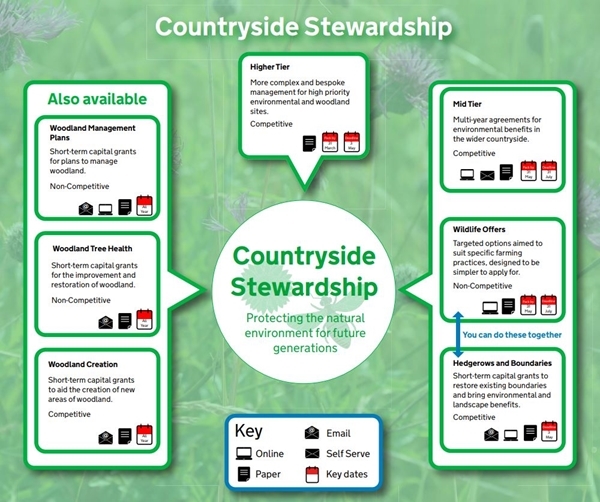By Jim Egan, Head of Development and Training for the Allerton Project
Monday 18th February – it’s not a particularly special day, no major anniversary or saint’s day. In 2019 it sees the opening of the Countryside Stewardship application window. From this day farmers and landowners can access information and application packs for agreements that will generally start on 1st of January 2020.
I must admit I know I’m not going to be deafened by the whooping and hollering of delight; in fact the opposite, I’m probably going to be greeted by groans of despair. The response from my office colleague @farmerphil1 will be “Jim it’s all well and good telling me the application process has improved but I need to be paid on time and I need my maps to be right and let me tell you about the way the RPA write to me...”
I have to say I can’t disagree with that view. BUT I think I’m confident enough to put my neck on the block and say I can see some very positive signs of change.
I’m not going to start to examine the recent history of Countryside Stewardship or even start to try and apportion blame for the state this important scheme finds itself in. All I will say is, I think, yet again we invested in an IT system that was not fit for purpose, we didn’t allow enough time and resources to build and test that system, we over complicated recording and evidence requirements and we lost sight of what engages people to deliver on farm.
On 18th February 2019 things are starting to change.
There will be a range of great leaflets that help to explain how the scheme works. Is Higher Tier for me? Should I be in Mid Tier? What are those Wildlife Offers? The literature available at the NFU conference and then more widely through a range of different route. You can see what they look like here. It’s a small step but this literature helps explain what your options are.

Where should you start?
The four Wildlife Offers introduced in 2018 are there again; it’s a straight forward online application process. You choose from a simple range of options...I know you have to print out your maps, colour them in and then scan them back in to your computer to complete your application. But it’s not that onerous.
This year you can also apply for a Hedgerow and Boundary Grant which sits alongside your wildlife offer. How long have you wanted to replant that hedge? Why haven’t you got around to laying that hedge or repairing that stone wall? Well now you can get paid to do it.
Even Core Mid Tier is relatively straight forward. It’s really worth thinking about this element of the scheme if you want to include capital works above and beyond hedges and walls or if you want to open up the list of options available to you. It’s definitely worthwhile if you are in a Catchment Sensitive Farming area; don’t forget you Catchment Sensitive Farming Officer can provide help and advice on your application. If you are in the right target area you can help with pesticide handling areas, farm tracks or concreting yards; what’s not to like?
Getting your application pack is easy. Log on to your Rural Payments Account – follow the links for Countryside Stewardship and you will arrive at the screen where you select the part of the scheme you want to apply for. Click the button and your application pack will be downloaded and sent to your Rural Payments portal.
To complete the application process for any elements of the scheme will only take a few hours for most farms. It might take you longer to choose which options go where but that’s business decision making and it’s not always quick or straight forward.
I’m confident enough in the improved application process and the change in approach that I’ve worked with the RPA and colleagues across the industry to produce some promotional material – have a look here:
So I’d like to say thank you to the Defra, RPA and Natural England teams - you’ve finally properly explained the schemes; you’ve vastly improved the application process and I’m now in a position where I’m very happy to promote an excellent scheme. Please don’t let me, and more importantly those farm businesses who want to engage and take part, down by not improving the way you pay them and the way you communicate with them.
Finally I’d like to say environmental management is not simple and as a result agri-environment schemes will never be simple. Remember farmers don’t grow crops without an agronomist, you don’t produce livestock without a vet so why are you expected to deliver environmental schemes without professional help and advice.